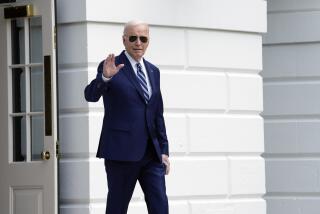Mexico Offers Alternative to ‘TwinPorts’ Plan : Airport: Mayor O’Connor meets with Mexican officials, who agree to joint panel to study proposals for binational airfield.
MEXICO CITY — Adding a new wrinkle to San Diego’s long-running airport debate, Mexican officials on Wednesday offered a counterproposal to the idea of a binational airfield: the expansion of Tijuana’s existing airport to serve both cities.
Communications and Transportation Minister Andres Caso Lombardo also suggested appointing a joint committee to study the San Diego and Mexican proposals and reach a compromise.
Neither Mayor Maureen O’Connor nor City Councilman Ron Roberts, the leading advocate of the binational airport proposal, could be reached for comment after their meeting here with Caso Lombardo.
However, other members of the trade mission that attended the meeting said their goal had been Mexican participation in a joint committee to explore binational efforts for solving the region’s airport needs and that was achieved.
Earlier in the day, Mexican President Carlos Salinas de Gortari agreed in principle to support creation of a joint committee to explore the possibility of a shared airport on Otay Mesa.
A beaming Mayor Maureen O’Connor announced Salinas’ decision shortly after meeting with him in the presidential residence of Los Pinos. A presidential spokesman later confirmed the statement.
“The first step starts with exploration,” O’Connor said. “There is no question this is a significant advance.”
The meeting with Caso Lombardo later in the day made it clear that while the Mexican government is interested in the binational airport, officials here have other options they want considered.
The Mexican counterproposal came a day after the San Diego City Council declared the “TwinPorts” plan as the city’s preferred long-range airport option. If TwinPorts is built, it would be the United States’ first binational airport, although at least one multinational airport currently exists in Europe, the Basel-Mulhouse airport on the Swiss-French border.
The plan is an effort to provide an alternative to overcrowded Lindbergh Field, which cannot be expanded because it is hemmed in by military facilities, commercial structures and residential areas.
The San Diego proposal is to expand Tijuana’s existing international airport northward across the border, adding a second runway and a tower on the U.S. side. Planes would land on either runway, then taxi to a gate on the appropriate side of the border.
Mexican officials agree that the Tijuana airport should be expanded. However, they believe the expansion should all take place on their side of the border.
They suggest an international gate with a tunnel to San Diego to serve U.S.-bound passengers.
One of the major purposes of the San Diego trade mission’s two-day trip to Mexico was to ask Salinas if he would support forming a bilateral committee to consider the feasibility of an airport, O’Connor said.
“We can go home with that question answered in the affirmative,” she said before the meeting with Caso Lombardo.
She also suggested to Salinas that one of the binational committee’s first efforts should be organizing a joint delegation to the Basel-Mulhouse airport.
More to Read
Sign up for Essential California
The most important California stories and recommendations in your inbox every morning.
You may occasionally receive promotional content from the Los Angeles Times.










